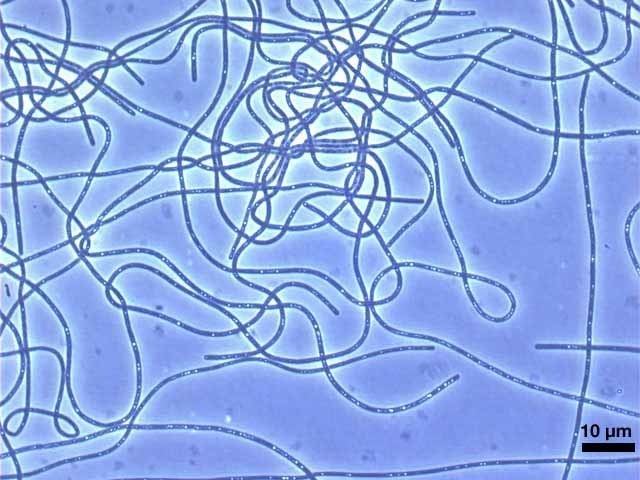Domain Bacteria Rank Phylum | Scientific name Chloroflexi Higher classification Bacteria | |
 | ||
Phylum Chloroflexi; (Garrity and Holt 2002) Hugenholtz and Stackebrandt 2004 Similar Bacteria, Acidobacteria, Planctomycetes, Gemmatimonadetes, Bacteroidetes | ||
The Chloroflexi or Chlorobacteria are a phylum of bacteria containing isolates with a diversity of phenotypes including members that are aerobic thermophiles, which use oxygen and grow well in high temperatures, anoxygenic phototrophs, which use light for photosynthesis (green non-sulfur bacteria), and anaerobic halorespirers, which uses halogenated organics (such as the toxic chlorinated ethenes and polychlorinated biphenyls) as energy sources.
Contents
Whereas most Bacteria, in terms of diversity, are diderms and stain Gram negative with the exception of the Firmicutes (low CG Gram positives), Actinobacteria (high CG gram positives) and the Deinococcus–Thermus group (Gram positive, but diderms with thick peptidoglycan), the members of the phylum Chloroflexi are monoderms, but stain mostly Gram negative.
History
The taxon name was created in the 2001 edition of Volume 1 of Bergey's Manual of Systematic Bacteriology and is the Latin plural of the name Chloroflexus, the name of the type genus of the phylum, a common practice.
In 1987, Carl Woese, regarded as the forerunner of the molecular phylogeny revolution, divided Eubacteria into 11 divisions based on 16S ribosomal RNA (SSU) sequences and grouped the genera Chloroflexus, Herpetosiphon and Thermomicrobium into the "Green non-sulfur bacteria and relatives", which was temporarily renamed as "Chloroflexi" in Volume One of Bergey's Manual of Systematic Bacteriology.
Being a deep branching phylum (cf. Bacterial phyla) its classification was analysed in Volume One of Bergey's Manual of Systematic Bacteriology and included a single class with the same name, the class Chloroflexi. Since 2001 however, new classes have been created thanks to newly discovered species, therefore currently the phylum Chloroflexi is divided into:
Regarding the class "Dehalococcoidetes", the placeholder name was given by Hugenholtz & Stackebrandt, 2004, after "Dehalococcoides ethenogenes" a partially described species in 1997, whereas the first species fully described was Dehalogenimonas lykanthroporepellens by Moe et al. 2009, but in the description of that species the class was not made official nor were families or orders laid out as the two species share only 90% 16S identity, meaning that they could fall in different families or even orders.
Recent phylogenetic analysis of the Chloroflexi has found very weak support for the grouping together of the different classes currently part of the phylum. The six classes that make up the phylum did not consistently form a well-supported monophyletic clade in phylogenetic trees based on concatenated sequences for large datasets of proteins and no conserved signature indels were identified that were uniquely shared by the entire phylum. However, the classes "Chloroflexi" and Thermomicrobia were found to group together consistently by both the usual phylogenetic means and the identification of shared conserved signature indels in the 50S ribosomal protein L19 and the enzyme UDP-glucose 4-epimerase. It has been suggested that the phylum Chloroflexi "sensu stricto" should comprise only the classes Chloroflexi and Thermomicrobia, and the other four classes ("Dehalococcoidetes," Anaerolineae, Caldilineae and Ktedonobacteria) may represent one or more independent phyla branching in the neighborhood of the Chloroflexi.
Phylogeny
The currently accepted taxonomy is based on the List of Prokaryotic names with Standing in Nomenclature (LPSN) and National Center for Biotechnology Information (NCBI) and the phylogeny is based on 16S rRNA-based LTP release 123 by 'The All-Species Living Tree' Project.
Notes:
♠ Strains found at the National Center for Biotechnology Information (NCBI) but not listed in the List of Prokaryotic names with Standing in Nomenclature (LSPN).
♪ Prokaryotes where no pure (axenic) cultures are isolated or available, i. e. not cultivated or can not be sustained in culture for more than a few serial passages.
Taxonomy
Genus "Kouleothrix" ♠ Kohno et al. 2002
Genus "Candidatus Chlorothrix" Klappenbach & Pierson 2004
Class Thermoflexia Dodsworth et al. 2014
Class Dehalococcoidia Löffler et al. 2013 ["Dehalococcoidetes" Hugenholtz & Stackebrandt 2004]
Class Anaerolineae Yamada et al. 2006
Class Ardenticatenia Kawaichi et al. 2013
Class Caldilineae Yamada et al. 2006
Class Ktedonobacteria Cavaletti et al. 2007 emend. Yabe et al. 2010 ["Ktedobacteria" (sic) Cavaletti et al. 2006]
Class Thermomicrobia Garrity and Holt 2002 emend. Hugenholtz and Stackebrandt 2004
Class Chloroflexia Gupta et al. 2013
Etymology
The name "Chloroflexi" is a Neolatin nominative case masculine plural of "Chloroflexus", which the name of the first genus described. The noun is a combination of the Greek adjective chloros, -a, on (χλωρός, -ά, -όν) meaning "greenish-yellow" and the Latin masculine passive perfect participle flexus (of flecto) meaning "bent" to mean "a green bending". It should be therefore noted that the etymology is not due to chlorine, an element (dephlogisticated muriatic acid air) which was confirmed as such in 1810 by Sir Humphry Davy and named after its pale green colour. Another phylum with the same root is Chlorobi, whereas Cyanobacteria has the root cyanos (κύανος) meaning "blue-green".
Unlike some other phyla, there is no theme root in the name of genera of Chloroflexi and in fact many genera beginning with "Chloro-" or ending in "-chloris" are either cyanobacteria or chlorobi.
